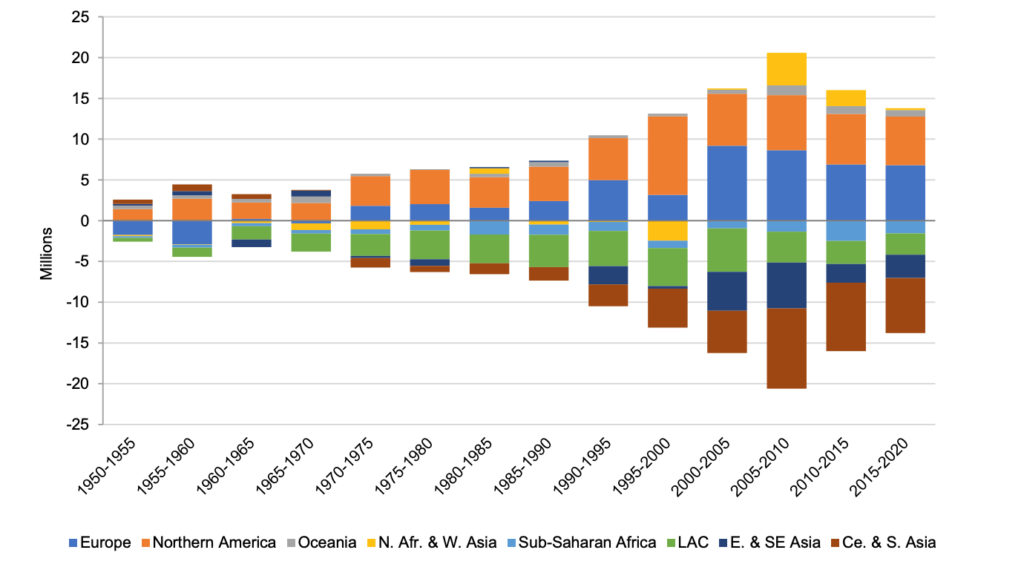This blog is part of the COMPAS Coronavirus and Mobility Forum.
The period since World War II has truly been an ‘age of migration’: global population movements became more extensive, complex, and central to key social transformations than ever before. But things changed after the Global Financial Crisis, and now the world is still in an almost total lockdown on human mobility and migration, as governments fight the 2020 Coronavirus Pandemic. What lasting effects will these lockdowns have on migration and mobility? Have we reached the end of the age of migration? Here I suggest ten key questions to guide migration and mobility research in the wake of the 2020 Pandemic.

Figure 1: Average annual net number of immigrants by region, from 1950-55 to 2015-20 (millions) Source: United Nations, Department of Economic and Social Affairs, Population Division (2019). International Migration 2019: Report (ST/ESA/SER.A/438), p. 21, Figure II.2. Forecast added.
1. Will countries need less labour migration?
During the Pandemic unemployment rates mushroomed to an extent that will almost certainly depress demand for immigrant labour in many countries. Firms that survive the great cull will have access to a large recruitment pool of unemployed native workers, and will face political pressures to employ native-born workers. Even though not all workers will retrain or take jobs perceived to be below their station, the net result will be economies less dependent on migrant labour.
2. Will migrant decision-making change?
The Pandemic may also be reshaping individual- and household-level decisions about migration. Some types of people may be less likely to move. Migration is a risky decision that may only pay off in the long term, and research shows that other major crises have made people more risk-averse and impatient. Other people may be more likely to move, particularly those who desperately need to send remittances to their families in developing countries, but have been unable to do so during lockdown. The net result may be a period of unpredictable and fast-changing migration flows.
3. Will anti-immigrant sentiment grow?
Anti-immigrant sentiment rises during recessions. Myths about immigrants stealing jobs or lazing around on unemployment benefits always resurface in times of high unemployment. Neither stereotype finds strong support in migration research. But the numbers matter less than the way they are are interpreted in political narratives, media stories, and urban myths. Migrants make convenient scapegoats for everything destabilizing about globalization, and thus the pandemic is exacerbating xenophobia and racism worldwide.
4. Will autocratic regimes suppress diversity?
The Pandemic is re-normalizing ‘big government’ after several decades of state-shrinking neoliberal consensus, as many governments launch colossal stimulus packages. Emergency measures have also involved classic authoritarian strategies of policing and political control. They have also involved the suspension of certain individual and minority rights, fuelling bullying of migrants and ethnic minorities, and suppression of social difference more broadly.
5. Will migration restrictions proliferate?
International migration controls had entered a restrictionist cycle well before the current lockdowns, but the coronavirus outbreak has been a convenient excuse for governments to cut migration even further. It is particularly likely that temporary labour migration programs and immigration points systems will proliferate as a way of attracting high-skilled migrants and circulating the low-skilled. And immigration controls are only part of the equation: emigration controls, hallmark of authoritarianism, may also be on the rise.
6. Will ‘travel bubbles’ become economic regions?
The travel industry is a major casualty of the Pandemic: it may never fully bounce back. The emerging alternative to reinstating global travel is forming ‘travel bubbles’ between states with similar virus risk profiles. These bubbles may coalesce into economic regions with shared manufacturing, trade and investment. The Economist Intelligence Unit is advising businesses to prepare for ‘The Great Unwinding’ of globalisation, through ‘the regionalisation of global supply chains’ due to the coronavirus restrictions.
7. Will international student migration recover?
From 2001 to 2017 international student migration soared from under 2.1 million to over 5.3 million, and now generates an estimated annual economic impact of US$300 billion, including both the direct dollar amount spent in fees and living expenses by international students, as well as ‘indirect and induced’ impacts such as spillovers onto jobs, tax revenues and household incomes. Many universities now rely on international student fees to subsidise research. Whole economies now depend on the international student industry, which generates employment, fills unskilled labour gaps, and – after graduation - provides a recruitment pool for highly skilled jobs. The coronavirus pandemic is devastating this business model.
8. Will commuter travel decline?
The Pandemic is accelerating existing trends of e-commerce, remote work, and ‘distant socializing’ enabled in the past two decades by fast internet and social media. Of all changes, the switch to remote working may be the most significant. Business analysts are anticipating that 25%-30% of the workforce will transition into working remotely permanently by 2021. Researchers of migration and transnationalism have a major stake in the study of these trends.
9. Will immobility reshape cities?
Such reductions in inter and intra-urban mobility may fundamentally reshape cities. For one thing, firms may no longer need – or be able to afford – centrally located headquarters. As The Economist puts it, ‘the need for workers to cluster together in offices has shaped every aspect of modern life’, and ‘if the pandemic has weakened the office’s hold on society, the implications will be profound’. Municipal councils may also need to review infrastructure plans made under assumptions of much higher net migration and commuter mobility.
10. Will demographic and mobility transitions change course?
Although the disease is a relatively small contributor to overall mortality, COVID-19 takes a heavy death toll among the elderly. If the Pandemic devastates this generation, it will affect long-term dependency ratios and dynamics of demographic and mobility transition. It could reduce the size of the elderly population relative to the working population, and/or cause a boom in lockdown babies, reversing or accelerating current demographic transition rates. As geographer Wilbur Zelinsky noted, such changes to demographic dynamics have implications for internal migration within and between rural and urban regions.
The end of the age of migration?
Taken together, these key questions contribute to a research agenda for studying human mobility after the most recent age of migration. In the coming years, migration and mobility researchers will play an important role in monitoring the impacts of the COVID-19 crisis, and highlighting the best role for international migration and human mobility in the new normal that emerges.
Read the full COMPAS Working Paper Migration and Mobility after the 2020 Pandemic: The End of an Age?
Alan Gamlen is Associate Professor of Geography at Monash University, a Research Associate at the University of Oxford, and Editorial Board Chair of the journal Migration Studies published by Oxford University Press.
Citation
Gamlen, A. (2020) Migration and Mobility after the 2020 Pandemic: The End of an Age? WP-20-146, Centre on Migration, Policy and Society, University of Oxford.

